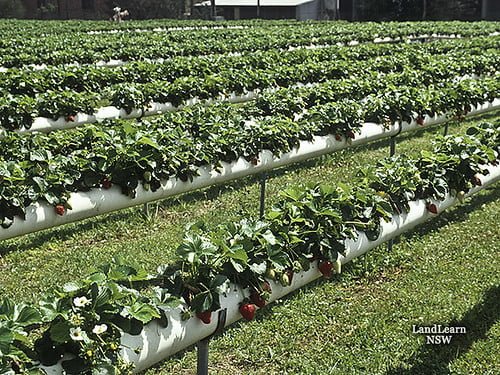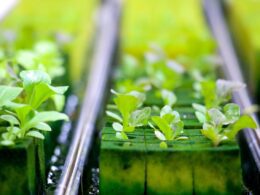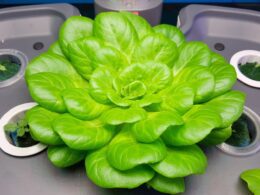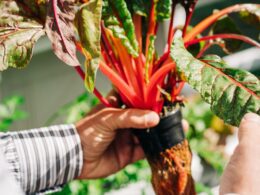Have you ever considered growing your own plants at home but felt overwhelmed by the idea of traditional gardening? If so, indoor hydroponics may be the perfect solution for you. This innovative method of gardening allows you to grow plants without soil, using nutrient-rich water instead.
But the question remains: do indoor hydroponics actually work?
The short answer is yes. In fact, indoor hydroponics has become increasingly popular in recent years due to its numerous benefits. From faster growth rates to greater control over plant nutrition, this method of gardening offers a variety of advantages over traditional soil-based gardening.
However, there are also some drawbacks to consider before diving into indoor hydroponics, and it’s important to understand the factors that can impact your success with this method. In this article, we’ll explore the concept of indoor hydroponics, the benefits and drawbacks of this method, and what you need to know before getting started.
Understanding the Concept of Indoor Hydroponics
You’ll gain a deeper understanding of the concept of cultivating plants without soil in an indoor environment with hydroponic systems. This indoor gardening technique involves growing plants in a water-based solution, using nutrients and minerals to feed the plants instead of soil. The roots of the plants are suspended in the solution, absorbing water and nutrients directly.
Hydroponic systems in an indoor environment provide several benefits over traditional soil-based gardening. One of the most significant benefits is the ability to control the environment in which the plants grow. Indoor hydroponic systems allow you to adjust the temperature, humidity, and lighting to meet the requirements of the plants you are growing. This level of control can result in faster growth rates and a higher yield of fruits and vegetables.
Another benefit of indoor hydroponic systems is that they use less water than traditional soil-based gardening. This is because hydroponic systems recirculate the water and nutrients, reducing waste.
In addition, indoor hydroponic systems can be set up in small spaces, making them an ideal option for apartment dwellers or those with limited outdoor space. With all these benefits, it’s no wonder that indoor hydroponic systems are becoming increasingly popular among gardeners and those interested in sustainable living.
Benefits of Indoor Hydroponics
Discover the amazing advantages of cultivating your own fresh and nutritious produce right from the comfort of your own home. With indoor hydroponics, you can have complete control over the environment your plants grow in, allowing you to improve sustainability and reduce your carbon footprint.
By using water instead of soil, hydroponics can save up to 90% of water usage compared to traditional farming methods. Plus, you can grow your own produce year-round, eliminating the need for transportation and reducing food waste.
Indoor hydroponics also allows you to maximize yields and produce higher quality crops. By controlling the nutrients, pH levels, and lighting, you can create the perfect growing environment for your plants. This means faster growth, more robust plants, and higher yields. Plus, since hydroponics eliminates the need for pesticides and herbicides, your produce will be healthier and safer to consume.
Overall, indoor hydroponics provides a sustainable and efficient way to grow your own fresh produce. With complete control over the growing environment, you can maximize yields, reduce waste, and produce healthier crops. So why not try it out and see the benefits for yourself?
Drawbacks of Indoor Hydroponics
Are you aware of the potential challenges that come with growing plants using a hydroponic system indoors? While indoor hydroponics offer many benefits, there are also some drawbacks that you should be aware of.
One of the biggest challenges of indoor hydroponics is the cost implications. Setting up a hydroponic system indoors can be quite expensive, especially if you’re using high-tech equipment.
Another challenge of indoor hydroponics is the maintenance. Hydroponic systems require a lot of attention and care, and this can be difficult to maintain if you’re not experienced. You need to monitor the pH levels, nutrient levels, and temperature of the water to ensure that your plants are healthy and thriving. Additionally, you need to be prepared to deal with any problems that may arise, such as pests or disease.
Despite these challenges, indoor hydroponics can be a great way to grow plants in a controlled environment. By doing your research and investing in the right equipment, you can overcome the cost implications and maintenance challenges and enjoy the benefits of indoor hydroponics.
With a little bit of effort, you can grow healthy, vibrant plants all year round, right in the comfort of your own home.
Factors to Consider Before Starting Indoor Hydroponics
Before you start growing your own plants using a hydroponic system, there are important factors to consider that can greatly impact your success.
First and foremost, you need to take into account the equipment cost. Hydroponic systems can be expensive, especially if you opt for a more sophisticated setup. Consider how much you’re willing to invest in your indoor hydroponic garden before making any purchases.
Next, take a look at the space availability in your home. Hydroponic systems require a certain amount of space to operate efficiently. You need to make sure that you have enough room to accommodate your setup without it being cramped or overcrowded. Think about where you’ll place your hydroponic garden and how much space you have to work with.
Lastly, you need to consider your level of commitment. Indoor hydroponics can be a time-consuming hobby. You need to be willing to invest time and effort into maintaining your garden. From monitoring the pH levels to ensuring proper nutrient levels, there are a lot of factors to consider. Make sure you have the time and dedication to put into your hydroponic garden before getting started.
In summary, before starting indoor hydroponics, it’s essential to take into account the equipment cost, space availability, and your level of commitment. By considering these factors, you can better determine if indoor hydroponics is the right choice for you. Remember to be realistic about your expectations and don’t be afraid to start small if you’re new to the hobby. With proper planning and dedication, you can have a successful indoor hydroponic garden.
Conclusion: Is Indoor Hydroponics Right for You?
If you’re willing to invest the time, money, and effort, you could have a thriving hydroponic garden right in your own home. Indoor hydroponics can be a great option for those who want to grow their own produce without the need for soil, pesticides, and herbicides.
However, before you dive into this type of gardening, it’s important to consider the cost comparison and environmental impact.
One of the biggest considerations when it comes to indoor hydroponics is the cost. While it can be more expensive to set up a hydroponic system than a traditional soil-based garden, it can also be more cost-effective in the long run. With hydroponics, you can control the environment, which means you can maximize yields and reduce waste. Additionally, because hydroponic plants grow faster and more efficiently, you may be able to save money on fertilizer and other inputs.
Another factor to consider is the environmental impact of indoor hydroponics. While it may seem like a more sustainable option because it doesn’t require soil or pesticides, there are other environmental factors to consider. For example, indoor hydroponic systems require electricity to power pumps and lights, which can have a significant impact on your carbon footprint. Additionally, many hydroponic systems rely on plastic containers and tubing, which can be difficult to recycle.
Overall, indoor hydroponics can be a great option for those who are willing to put in the time and effort to set up and maintain a system. However, before you get started, it’s important to carefully consider the costs and environmental impact. If you decide that indoor hydroponics is right for you, it can be a rewarding and sustainable way to grow your own produce.
Frequently Asked Questions
What types of plants grow best in indoor hydroponics?
When it comes to indoor hydroponics, both herbs and vegetables can thrive well if you optimize your set-up for maximum yield. Herbs like basil, mint, and parsley grow well in hydroponics, while vegetables like lettuce, spinach, and kale also do well.
To optimize your indoor hydroponics, make sure you have the right lighting, nutrients, and pH levels. You can also use a timer to ensure your plants get the right amount of light and water.
With these tips, you can get a high yield of fresh herbs and vegetables from your indoor hydroponics set-up.
Can indoor hydroponic systems be used for commercial farming?
Vertical farming through indoor hydroponic systems has proven to be a highly scalable and efficient method for commercial farming. This method maximizes space utilization while minimizing water usage and reducing the need for pesticides by stacking trays of plants vertically. The controlled environment of indoor hydroponic systems also allows for year-round crop growth, ensuring a steady supply of fresh produce.
This innovative technology has gained popularity among urban farmers and restaurant owners alike, who prioritize sustainability and the freshest ingredients. In short, indoor hydroponics are a viable solution for commercial farming, offering a safe and reliable way to produce high-quality crops in a controlled environment.
Do indoor hydroponic systems require a lot of maintenance?
Maintaining an indoor hydroponic system requires a certain time commitment and the right equipment. It’s important to regularly check the system’s pH levels and nutrient solution to ensure proper plant growth. You’ll also need to keep an eye on the lighting and temperature, as they can affect plant growth.
However, with the right setup and routine maintenance, indoor hydroponics can be a rewarding way to grow your own produce. It’s a safe and controlled environment, free from pests and harsh weather conditions that can damage outdoor crops.
How does the cost of indoor hydroponics compare to traditional soil-based gardening?
When it comes to cost comparison between indoor hydroponics and traditional soil-based gardening, an efficiency analysis shows that indoor hydroponics can be more expensive upfront but can save you money in the long run.
While traditional gardening requires purchasing soil, fertilizers, and pesticides, indoor hydroponics only requires a nutrient solution and electricity to power the system.
Additionally, indoor hydroponics can produce higher yields in a smaller space, allowing for more efficient use of resources.
Overall, while the initial investment may be higher, the cost savings and efficiency of indoor hydroponics make it a worthwhile investment for those looking to grow their own produce.
Are there any environmental concerns associated with indoor hydroponics?
If you’re considering indoor hydroponics, it’s important to think about the environmental impact and sustainability of this type of gardening.
While hydroponics can be more efficient in terms of water usage and space, there are still some concerns to consider.
For example, the energy used to power indoor grow lights can have a significant carbon footprint.
Additionally, the chemicals and nutrients used in hydroponic systems can have negative effects on the environment if not disposed of properly.
It’s important to research and implement sustainable practices, such as using renewable energy sources and composting waste, to minimize the environmental impact of indoor hydroponics.
By being mindful of these issues, you can still enjoy the benefits of indoor hydroponics while minimizing your impact on the environment.
Conclusion
So, is indoor hydroponics right for you? Well, it depends on your circumstances and preferences. If you have limited outdoor space or live in an area with harsh weather conditions, indoor hydroponics can be a great way to grow your own fresh produce year-round.
However, it’s important to consider the drawbacks, such as the initial investment cost and the need for consistent monitoring and maintenance. If you’re willing to put in the effort and resources, indoor hydroponics can be a rewarding and sustainable way to grow your own food.
Ultimately, the decision is yours. Happy growing!









